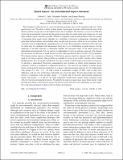Quark masses: An environmental impact statement
Author(s)
Kimchi, Itamar; Jenkins, Alejandro; Jaffe, Robert L.
DownloadJaffe-2009-Quark masses_ An env.pdf (909.2Kb)
PUBLISHER_POLICY
Publisher Policy
Article is made available in accordance with the publisher's policy and may be subject to US copyright law. Please refer to the publisher's site for terms of use.
Terms of use
Metadata
Show full item recordAbstract
We investigate worlds that lie on a slice through the parameter space of the standard model over which quark masses vary. We allow as many as three quarks to participate in nuclei, while fixing the mass of the electron and the average mass of the lightest baryon flavor multiplet. We classify as congenial worlds that satisfy the environmental constraint that the quark masses allow for stable nuclei with charge one, six, and eight, making organic chemistry possible. Whether a congenial world actually produces observers capable of measuring those quark masses depends on a multitude of historical contingencies, beginning with primordial nucleosynthesis and including other astrophysical processes, which we do not explore. Such constraints may be independently superimposed on our results. Environmental constraints such as the ones we study may be combined with information about the a priori distribution of quark masses over the landscape of possible universes to determine whether the measured values of the quark masses are determined environmentally, but our analysis is independent of such an anthropic approach. We estimate baryon masses as functions of quark masses via first-order perturbation theory in flavor SU(3) breaking. We estimate nuclear masses as functions of the baryon masses using two separate tools: for a nucleus made of two baryon species, when possible we consider its analog in our world, a nucleus with a similar binding energy, up to Coulomb contributions. For heavy nuclei or nuclei made of more than two baryons, we develop a generalized Weizsäcker semiempirical mass formula, in which strong kinematic flavor symmetry violation is modeled by a degenerate Fermi gas . We check for the stability of nuclei against fission, strong particle emission (analogous to α decay), and weak nucleon emission. For two light quarks with charges 2/3 and -1/3 , we find a band of congeniality roughly 29 MeV wide in their mass difference, with our own world lying comfortably away from the edges. We also find another, less robust region of congeniality with one light, charge -1/3 quark, and two heavier, approximately degenerate quarks with charges -1/3 and 2/3. No other assignment of light quark charges yields congenial worlds with two baryons participating in nuclei. We identify the region in quark mass space where nuclei would be made from three or more baryon species. We discuss issues relevant to the congeniality of such worlds, but a full characterization of them is left for future investigation.
Date issued
2009-03Department
Massachusetts Institute of Technology. Center for Theoretical Physics; Massachusetts Institute of Technology. Department of PhysicsJournal
Physical Review D
Publisher
American Physical Society
Citation
Jaffe, Robert L., Alejandro Jenkins, and Itamar Kimchi. “Quark masses: An environmental impact statement.” Physical Review D 79.6 (2009): 065014. © 2009 The American Physical Society.
Version: Final published version
ISSN
1550-2368
1550-7998